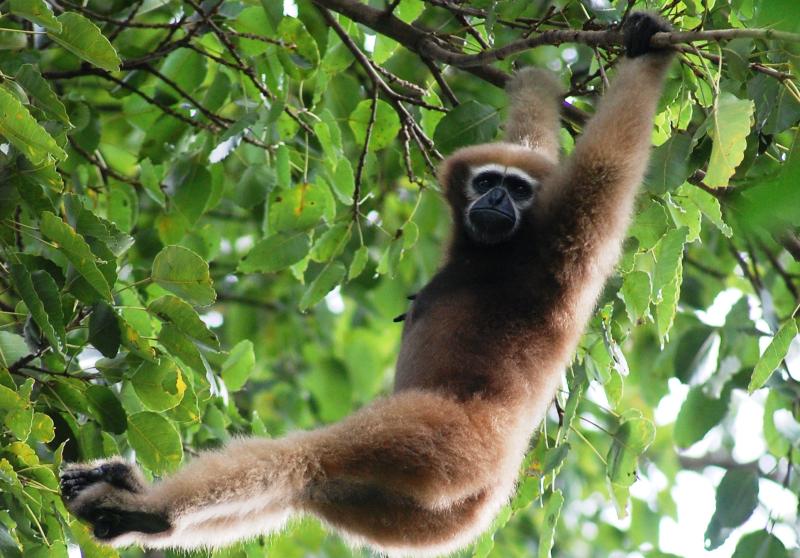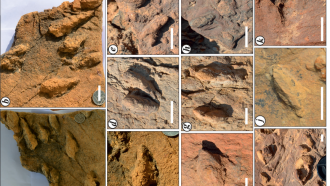
A Hoolock Gibbon from Meghalaya [Image Credits: Programme HURO / CC BY-SA (https://creativecommons.org/licenses/by-sa/3.0)]
The specimen, which is millions of years older than any previously known fossil, highlights their migration from Africa to Asia.
Gibbons, or ‘lesser apes’, are found in the forests of Asia, ranging from Northeast India to southern China and Borneo with over a dozen species. In India, the western Hoolock gibbons are found in all states in the northeast. The eastern Hoolock gibbons, on the other hand, are found only in parts of Arunachal Pradesh and Assam. The gibbon family of primates is thought to have split from their closest relatives, the great apes, over 20 million years ago. However, very few ape fossils have documented their evolution since. The closest known fossil to present-day gibbons belongs to the Yuanmoupithecus genus, which was found in China.
Now, a new ape fossil discovered near Ramnagar in Jammu and Kashmir may help fill some gaps in understanding how gibbons evolved and migrated to other parts of the world. The discovery, published in the journal Proceedings of the Royal Society B, also outlines how this newly-discovered fossil compares against previous fossil and living species of these apes. The research team consisted of palaeontologists from many institutes in the USA, and the Panjab University in India.
The fossil specimen, a single molar, is thought to be of a small ape whose dental structures are closest to today’s gibbons. The similarities exceed that of the fossil of Yuanmoupithecus, which dates back to 7–9 million years ago. The new specimen, named Kapi ramnagarensis, has extended our knowledge of fossilised gibbons by about 5 million years and is now the earliest known gibbon species in the fossil record! This ape is estimated to have lived 12.5–13.8 million years ago. The genus name Kapi comes from the Hindi word kapi which means ape or monkey that resembles a human being. The species name ramnagarensis is a reference to Ramnagar, where the fossil was found.

Map illustrating the location of Kapi (black star) relative to modern (dark green) and historical (light green) populations of lesser apes and the approximate distribution of early fossil apes in East Africa (blue triangles). Green triangles mark the location of previously discovered fossil gibbons. [Image Credits: Luci Betti-Nash]
“We initially started working at Ramnagar because we were interested in ape and primate evolution. This site is a relatively well-known area that has produced fossil ape specimens in the past,” says Christopher Gilbert, the lead author of the study. He is a Professor in the Department of Anthropology, Hunter College, New York. The first documented ape specimen, from an early relative of the living orangutan called Sivapithecus, was found at Ramnagar in 1922, almost exactly 100 years ago.
The researchers compared the dental features of the newly-found fossil with 165 other dental specimens of existing and extinct primates. The comparisons and analyses indicate that the Kapi genus is a closer ancestor of present-day gibbons than Yuanmoupithecus. The structural differences between these two genera suggest that Yuanmoupithecus belongs to an earlier species of the gibbon family. However, more fossil records are needed to better understand the evolution of gibbons. The researchers speculate that this new specimen could be a connection between the extinct and existing gibbon species as it exhibits certain features seen in both.

Photograph of the fossil tooth (Kapi ramnagarensis). [Image credits: Christopher C Gilbert]
The discovery in Ramnagar, the researchers say, could add strength to the hypothesis that gibbons migrated to Asia from Africa around the same time as Sivapithecus, which is also known in India from ~13 to 8.5 million years ago. The analyses of Kapi and Yuanmoupithecus specimens also find a possibility of evolution from early ape species in Africa that are similar in their dental structure to extinct primate species close to the gibbons.
While this discovery does not directly provide insights into how humans migrated out of Africa, it has other implications in understanding primate dispersion. “Besides the significance of being the oldest known fossil lesser ape by millions of years, Kapi establishes that lesser apes were in Asia by thirteen million years ago and were, in fact, associated with great apes, very similar to the situation we see today with orangutans and gibbons,” says Christopher. “This means that there may have been a larger ape dispersal event from Africa to Asia around this time involving both great apes and lesser apes, and we appear to be catching a window into that event as they pass through South Asia on their way to establishing their recent and current distributions in East and Southeast Asia,” he explains.
The researchers plan to continue to unearth such hidden fossils in Ramnagar for a few more years after the COVID-19 pandemic subsides, and it is feasible to continue their work.
“The next step would be to study the habitat of such primates and associated mammals to understand how climate change has influenced their evolution”, says Dr Rajeev Patnaik, Professor at Panjab University and an author of the study.






